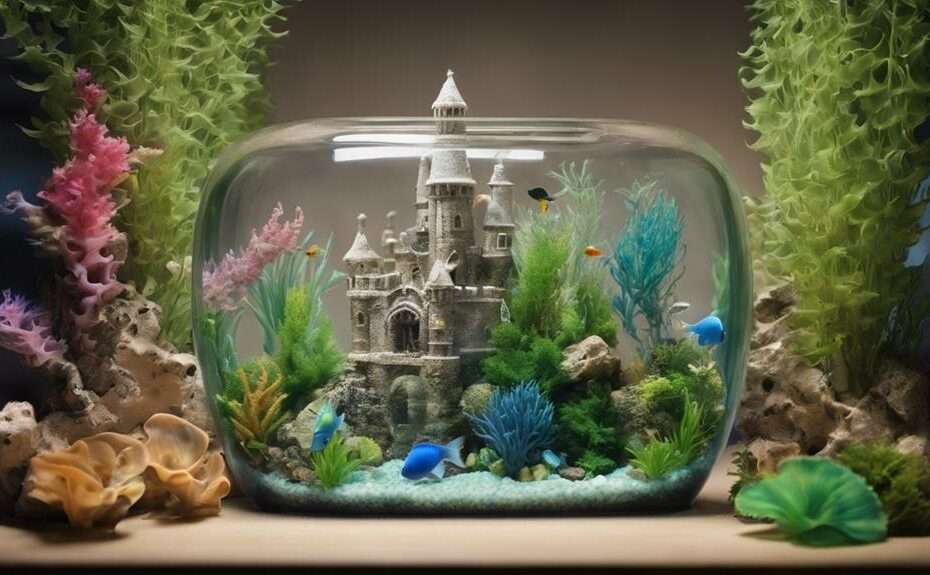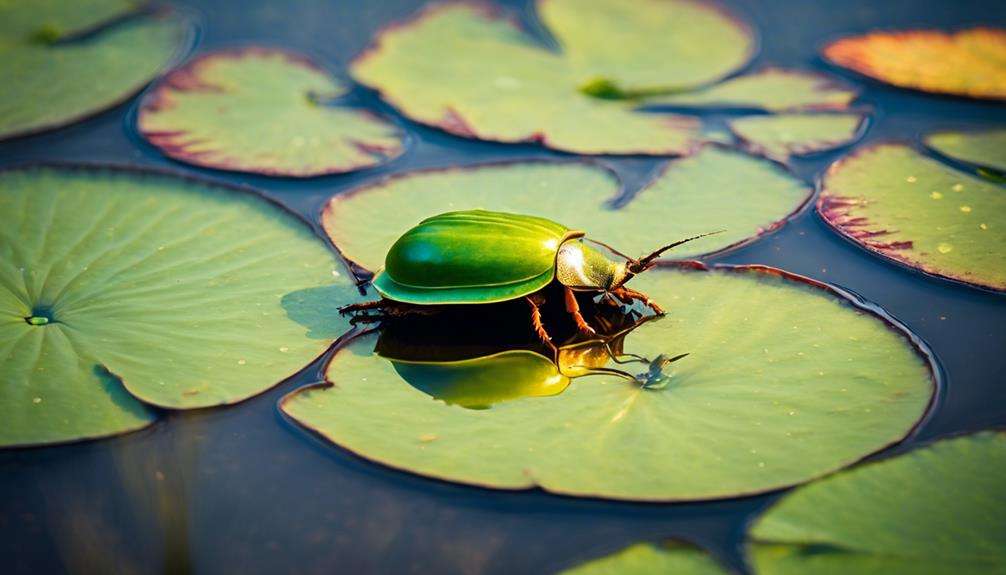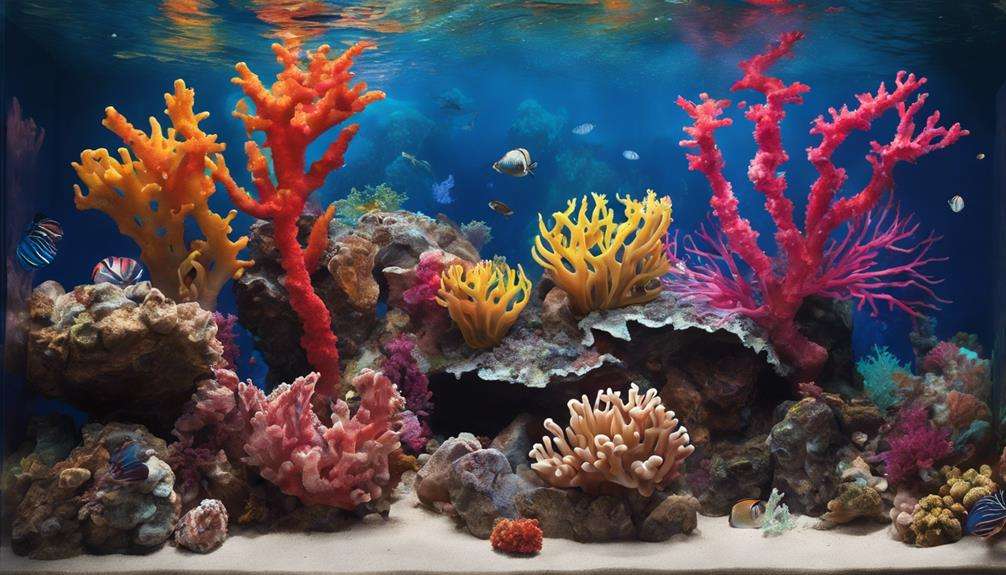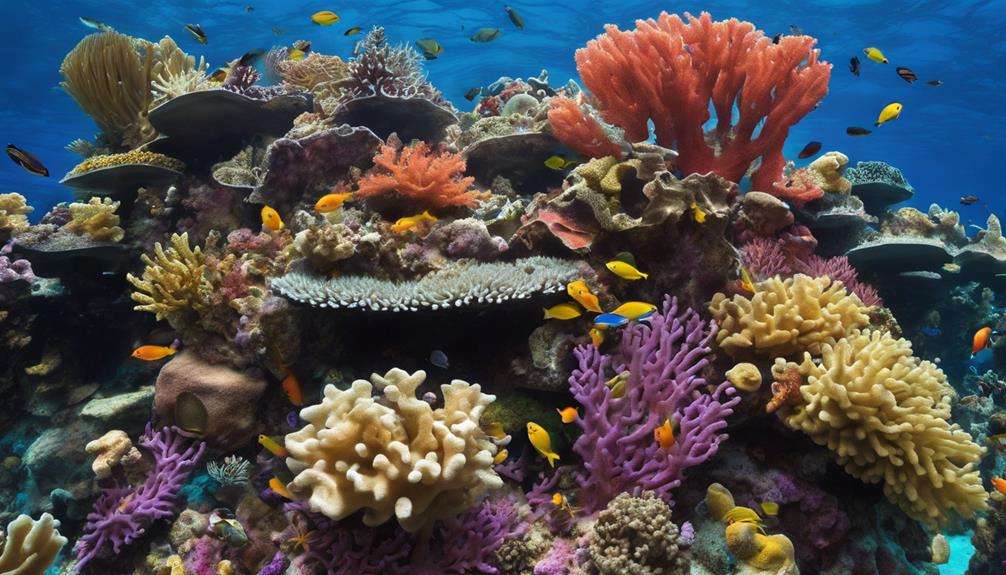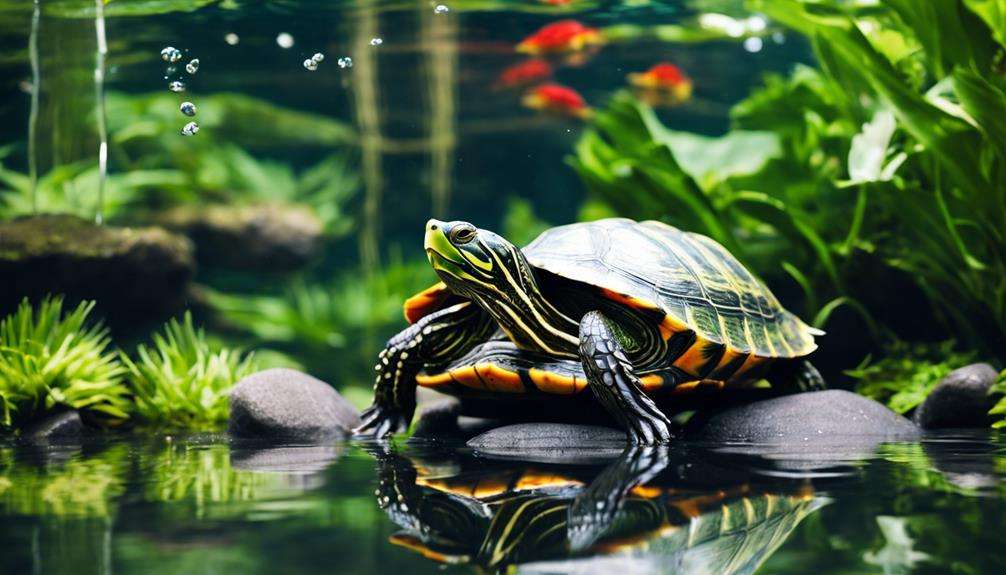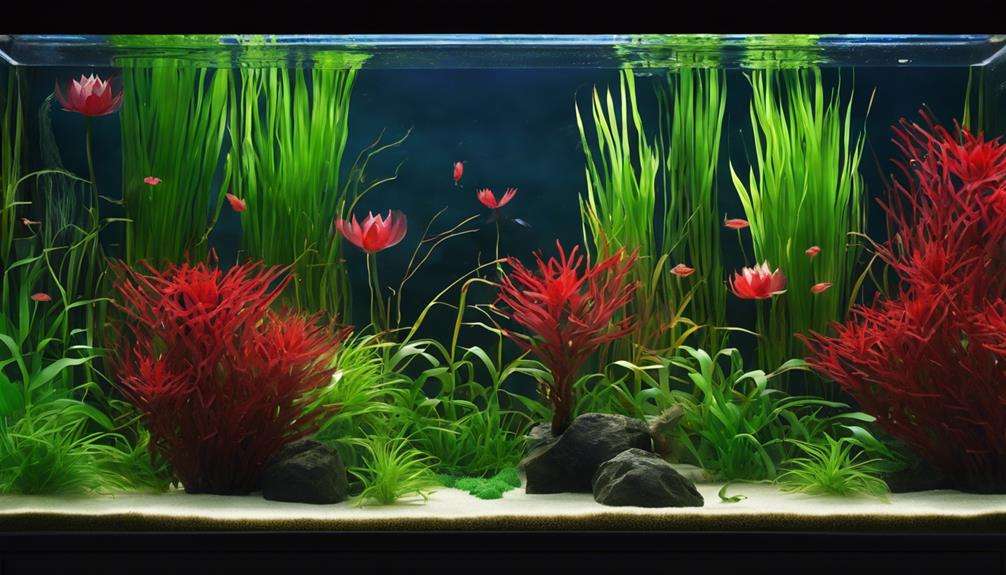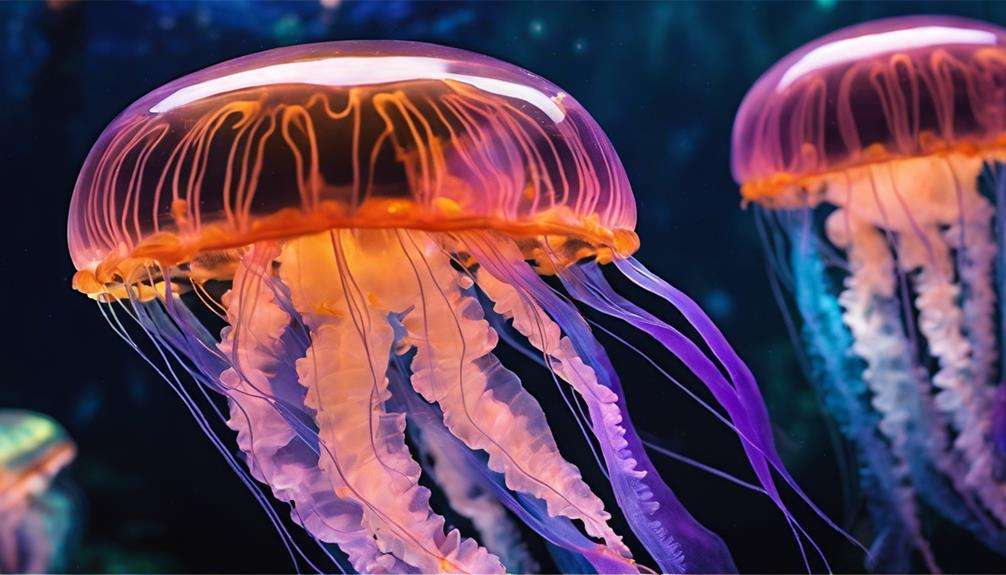In the intricate world of dwarf seahorses, caring for them is like tending to a delicate underwater garden. Ensuring the well-being of these tiny creatures involves a meticulous approach that can be both rewarding and challenging.
As you navigate through the nuances of their care, understanding the nuances of their environment and dietary needs can make all the difference in their longevity and overall health.
So, let's explore the essential tips that will aid you in providing top-notch care for these enchanting marine wonders.
Key Takeaways
- Maintain stable water parameters and a natural habitat for seahorse health.
- Use gentle filtration and aeration to prevent stress and strong currents.
- Feed enriched brine shrimp nauplii daily and monitor feeding effectiveness.
- Provide hiding spots for breeding success and fry survival in the tank.
Preparing the Tank
When setting up the tank for dwarf seahorses, make sure to use a minimum tank size of 5 gallons to provide ample space for their comfort and well-being. Dwarf seahorses are delicate creatures that require specific conditions to thrive. It's important to maintain stable water parameters such as temperature, salinity, and pH within the recommended range.
To make sure the well-being of your seahorses, opt for gentle filtration to prevent strong currents that may stress them. Including live rock in the tank setup is vital as it provides perching and hiding spots for the seahorses. Additionally, live rock contributes to the biological filtration of the tank, aiding in maintaining water quality.
Introducing macroalgae to the tank not only enhances the aesthetic appeal but also serves as a food source for the seahorses and a substrate for egg laying. By carefully considering tank size, water parameters, filtration, live rock, and macroalgae, you're creating an environment where your dwarf seahorses can thrive.
Optimal Tank Decor
To establish an ideal environment for your dwarf seahorses, carefully selecting and arranging the best tank decor is important for their well-being and natural behaviors. Providing thin hitching posts like live macroalgae or sea fans offers the seahorses surfaces to grip onto, promoting their natural behavior of holding onto objects in their habitat. Artificial coral decorations not only add visual appeal to the tank but also serve as additional perching spots for the seahorses to rest on. Live macroalgae and sea fans come in a variety of shapes and colors, enhancing the aesthetics of the tank while providing suitable surfaces for the seahorses.
It's vital to avoid introducing live corals or macroalgae that may bring hydroids into the tank, as these can be harmful to dwarf seahorses. By creating a natural habitat with suitable decor, you can help reduce stress and encourage natural behaviors in your seahorses, ultimately contributing to their overall well-being.
Filter and Air Setup
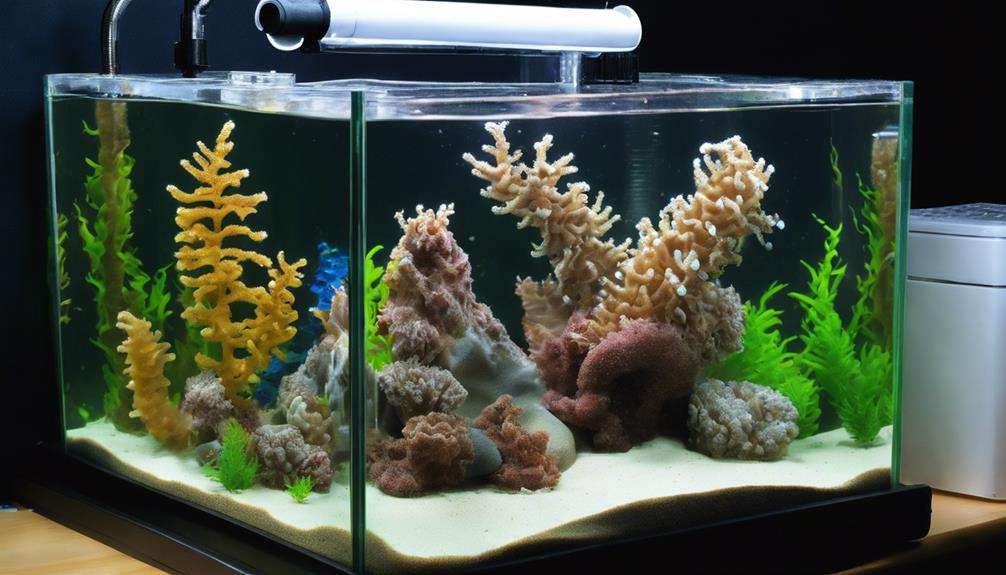
Consider utilizing small HOB filters or sponge filters in your dwarf seahorse tank to ensure efficient filtration. Adequate filtration is important for maintaining water quality by eliminating debris and waste.
Additionally, employing air pumps can help create gentle water movement without generating strong currents.
Filter Types for Seahorses
Hang-on-back (HOB) filters are a recommended choice for maintaining excellent water quality in dwarf seahorse tanks due to their gentle water flow.
Sponge filters are ideal for dwarf seahorses as they offer efficient biological filtration, ensuring a healthy environment.
Air-driven filters, commonly used for dwarf seahorses, help minimize strong currents, which can stress these delicate creatures.
Incorporating filter floss in the filtration setup is beneficial as it traps debris, preventing water cloudiness.
A vital filtration setup is essential for the overall well-being of dwarf seahorses, providing a clean and stable aquatic habitat.
Importance of Aeration
Incorporating proper aeration techniques into your dwarf seahorse tank setup is essential for ensuring ideal oxygen levels and water circulation. For dwarf seahorses, aeration plays a crucial role in maintaining water quality by facilitating gas exchange and promoting oxygenation.
Utilizing efficient filtration systems helps in removing waste and debris, further enhancing the overall water conditions for your seahorses. Consider using air pumps with air stones or sponge filters to provide additional aeration within the tank.
It's important to conduct regular maintenance on your aeration equipment to ensure optimal functionality and a healthy environment for your dwarf seahorses. By prioritizing aeration and filtration in your tank, you can create a stable and thriving habitat for your beloved seahorses.
Proper Water Circulation
To guarantee ideal water circulation in a dwarf seahorse tank, utilize a small HOB filter or a sponge filter to provide gentle flow without causing stress to the seahorses. Adjust the filter's flow rate to prevent strong currents that could agitate the seahorses.
Proper water circulation plays a vital role in distributing oxygen and essential nutrients throughout the tank, ensuring the well-being of the seahorses. Additionally, consider incorporating air stones in the tank to boost oxygen levels without generating excessive water movement.
Finding the right balance between filtration and aeration is paramount for maintaining a healthy environment for dwarf seahorses. By implementing these practices, you can create a harmonious aquatic habitat that promotes the flourishing of your delicate seahorse companions.
Maintaining Tropical Water Temperature
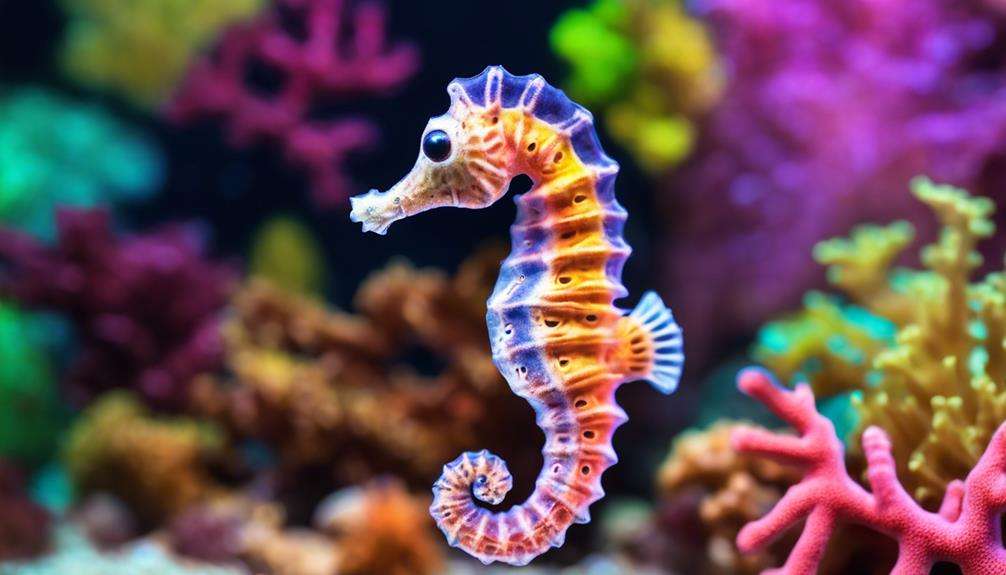
Maintain the perfect tropical water temperature of 72-74 degrees Fahrenheit for dwarf seahorses using a reliable aquarium heater. Stability in water temperature is essential for the health and vitality of dwarf seahorses. Fluctuations outside the recommended range can stress the seahorses and weaken their immune systems, making them more susceptible to diseases.
To guarantee the water temperature remains ideal, invest in a quality aquarium heater and regularly monitor its settings. Adjust the heater as needed to prevent any deviations from the ideal temperature range. Remember that sudden changes in temperature can be harmful, so make gradual adjustments when necessary.
Monitoring Water Quality
Regular monitoring of water quality parameters is essential for ensuring a healthy environment for dwarf seahorses in your aquarium. Test the pH, nitrates, nitrites, and ammonia levels regularly to maintain them within the suitable range for dwarf seahorses' well-being.
Keep a close eye on temperature fluctuations as these can stress the seahorses; maintain the water temperature between 72-74 degrees Fahrenheit. Additionally, monitor salinity levels consistently using a reliable hydrometer or refractometer to guarantee it stays stable around 1.023-1.025, which is vital for the health of dwarf seahorses.
Be vigilant for any signs of ammonia spikes or nitrate accumulation, as these can be detrimental to your seahorses and require immediate attention. Utilize water test kits to accurately measure these parameters and make any necessary adjustments promptly to provide a safe and thriving habitat for your dwarf seahorses.
Monitoring these water quality parameters diligently will help prevent potential health issues and guarantee the well-being of your aquatic pets.
Feeding Instructions
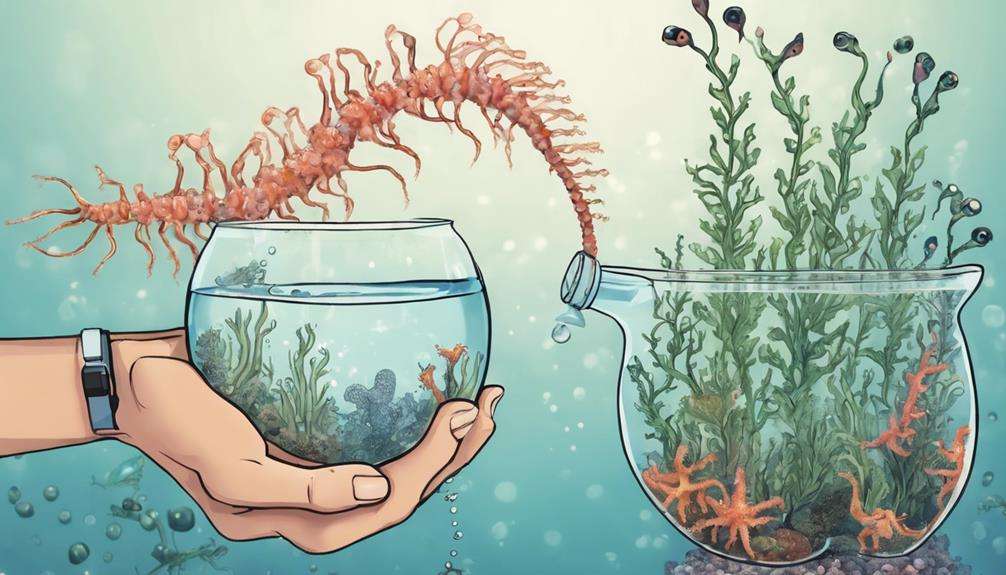
For high-quality nutrition, make sure that dwarf seahorses are fed live enriched brine shrimp nauplii daily. Gut-loading the brine shrimp before feeding is essential as it enhances the nutritional value that's passed on to the dwarf seahorses. To maintain water quality in your tank, promptly remove any uneaten live food to prevent ammonia spikes and other issues. Offering a combination of newly enriched and older food sources helps provide a balanced diet for these delicate creatures.
When it comes to feeding, using tiny broken-up frozen brine or Mysis shrimp may not suffice for the survival and overall health of your dwarf seahorses. These creatures thrive on live baby brine shrimp, which should be a staple in their diet. Additionally, regular tank maintenance is essential to make sure that the feeding regimen is effective. By adhering to these feeding instructions and maintaining a proper diet, you can help your dwarf seahorses thrive in their aquatic environment.
Breeding and Reproduction
Breeding prolifically, dwarf seahorses exhibit a fascinating reproductive strategy where females deposit eggs into the male's brood pouch for gestation. The gestation period for dwarf seahorses typically lasts around 10-14 days before the male gives birth to live young, known as fry.
To guarantee the successful breeding of dwarf seahorses, providing ample hiding spots in the tank for newborn seahorses is important for their survival and protection. Unlike some other species, breeding dwarf seahorses doesn't require human intervention, as they naturally care for their offspring once born.
It's essential to monitor tank conditions closely to maintain ideal water quality and temperature, which is essential for successful breeding and fry care. By creating a suitable environment with proper hiding spots and diligently observing tank conditions, you can support the health and well-being of both adult and newborn dwarf seahorses in your care.
Frequently Asked Questions
How Do You Take Care of a Dwarf Seahorse?
To care for a dwarf seahorse, maintain ideal water quality through daily feedings of live enriched brine shrimp. Use a suitable tank size with no aggressive tank mates, adequate lighting, and gentle handling techniques for their well-being.
Are Dwarf Seahorses Easy to Keep?
Keeping dwarf seahorses isn't easy. They require meticulous care with daily feedings, stable water parameters, and suitable tank setups. Research thoroughly, commit to their demands, prevent hydroid infestations, and provide proper nutrition for their well-being.
How Do You Take Care of a Seahorse at Home?
To care for a seahorse at home, set up a 5-gallon tank with sand and hitching posts. Feed live baby brine shrimp multiple times daily. Maintain pH at 8.2, temperature at 74°F, and do 10-25% water changes weekly. Choose gentle tank mates like snails or microstars.
Do Dwarf Seahorses Need a Heater?
Do dwarf seahorses need a heater to thrive in captivity? Absolutely. Maintaining water temperature stability, ideally at 72-74 degrees Fahrenheit, is crucial. Reliable aquarium heaters with thermostats are essential to prevent stress and guarantee their well-being.
Conclusion
To wrap up, creating a thriving environment for dwarf seahorses requires attention to detail and dedication. Imagine a miniature underwater world, filled with delicate creatures gracefully gliding through crystal-clear waters.
By following these tips for care at home, you can guarantee the health and happiness of your dwarf seahorses, allowing them to flourish in a setting that mimics their natural habitat.
Delve into the fascinating world of dwarf seahorses and watch them thrive under your expert care.
